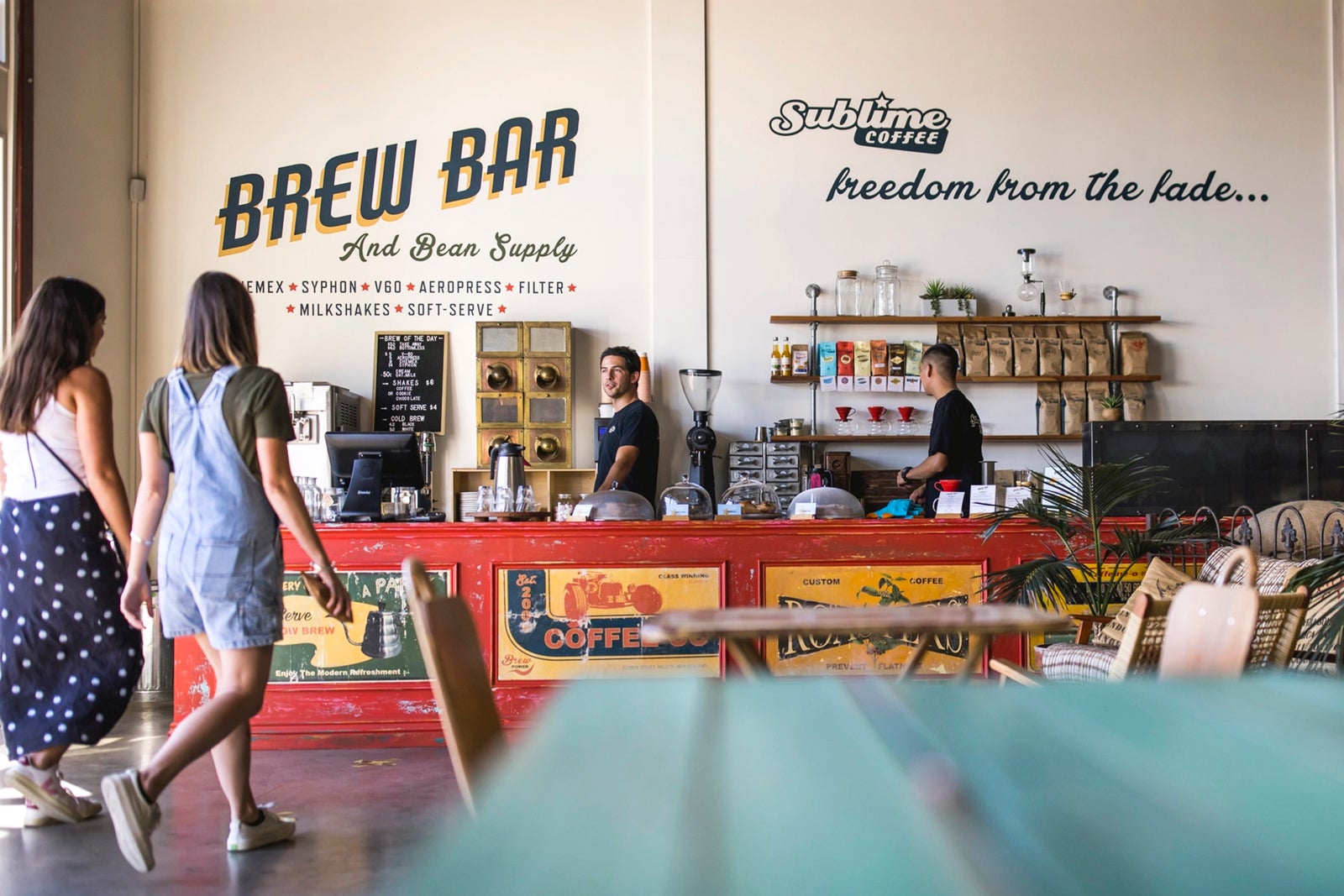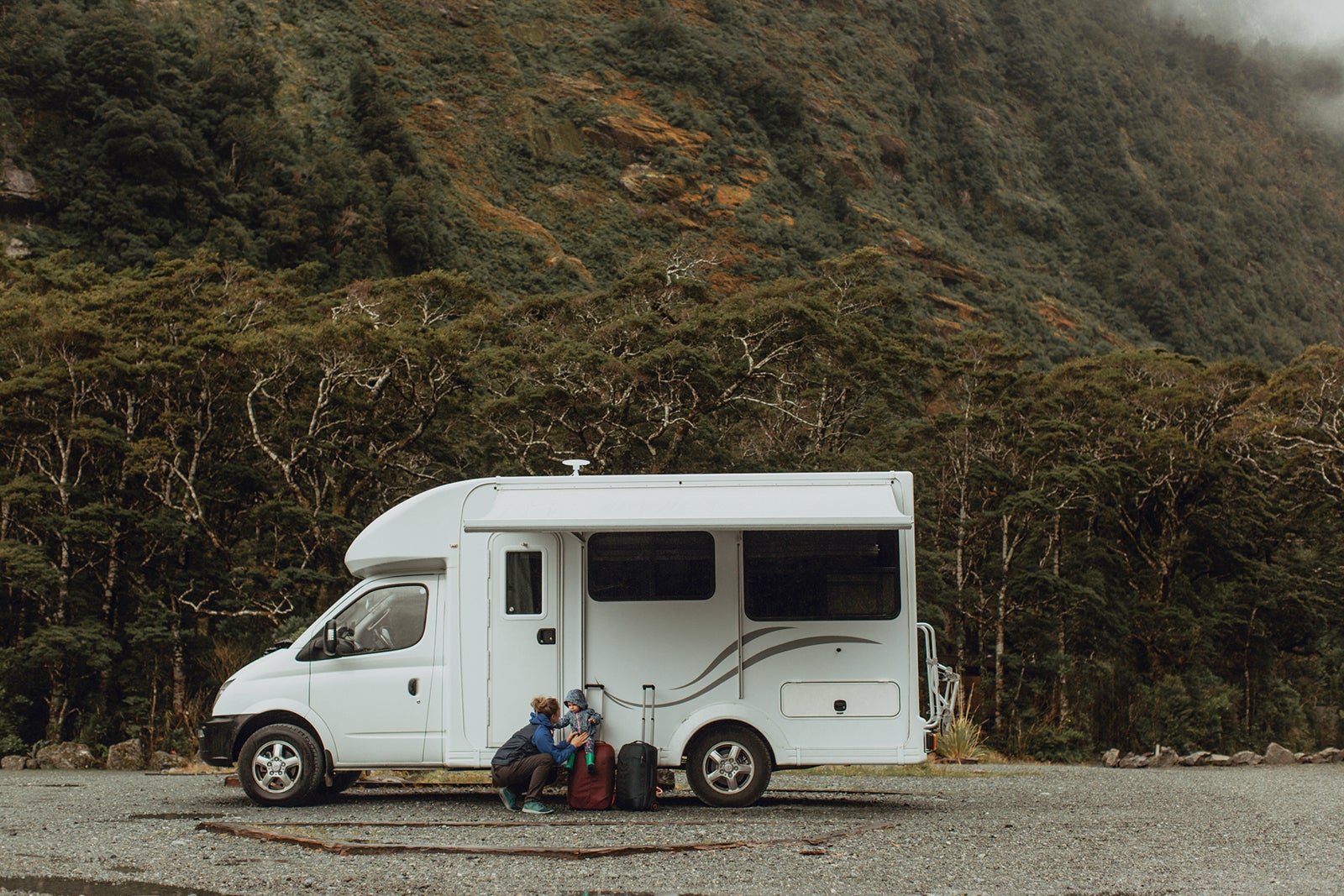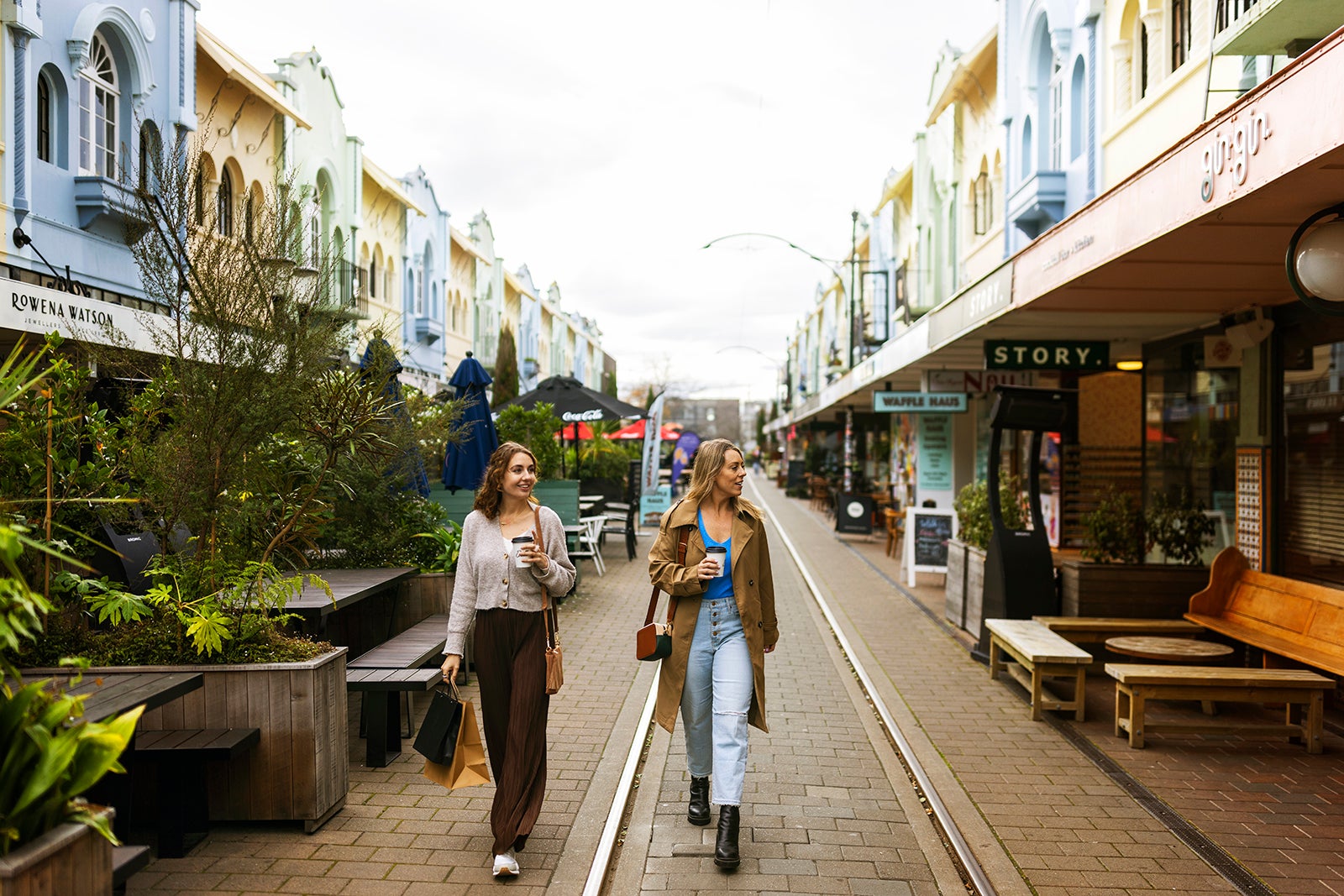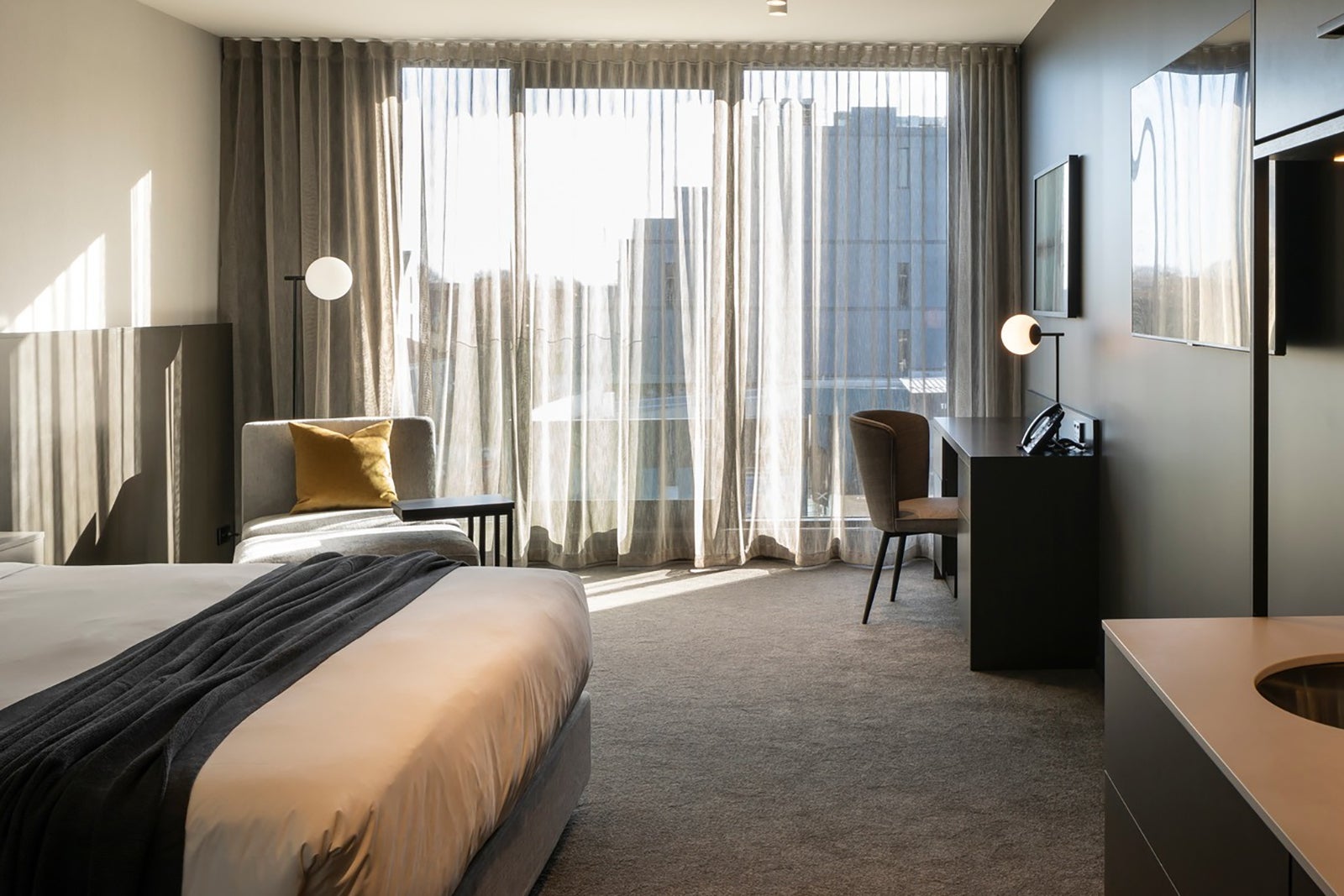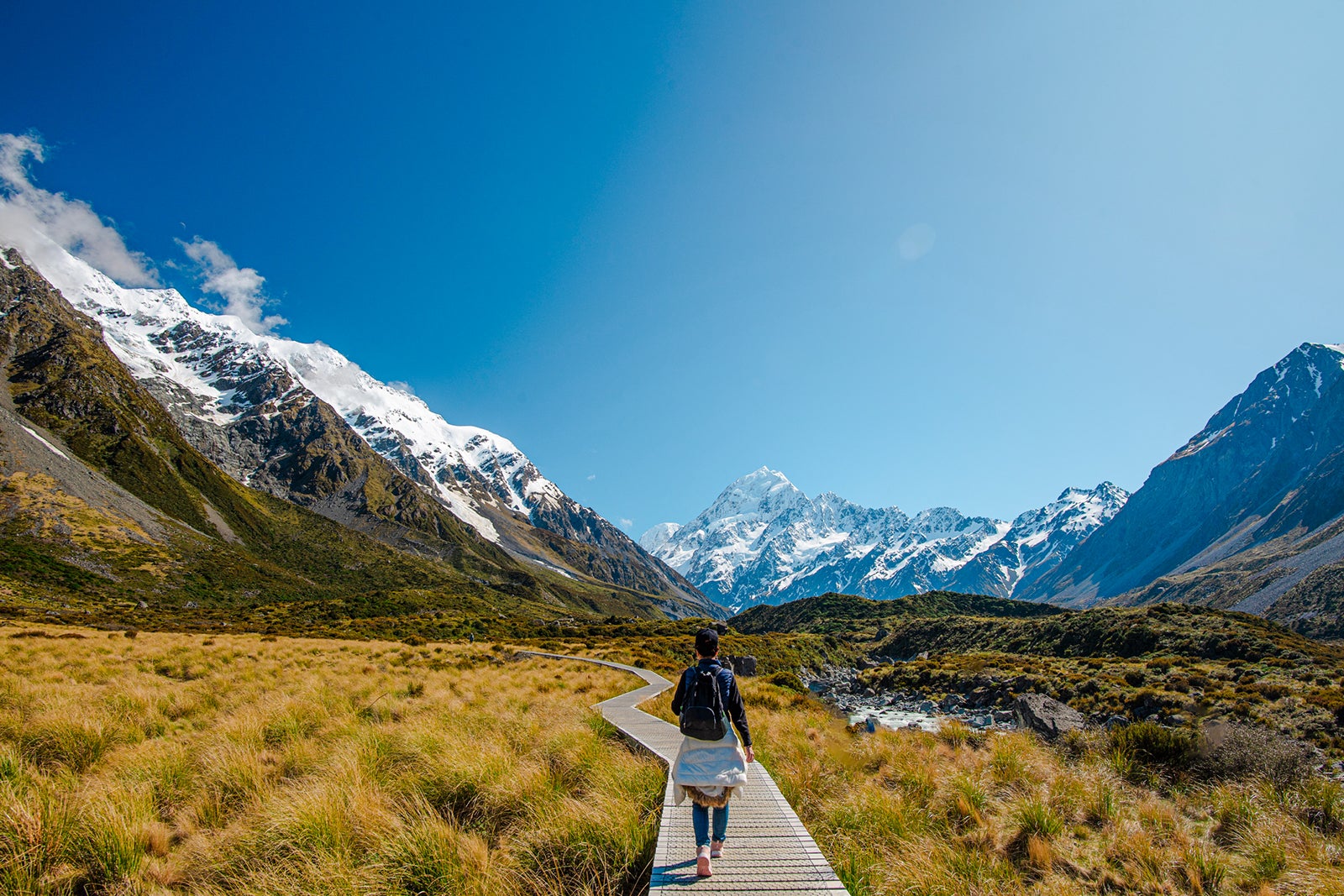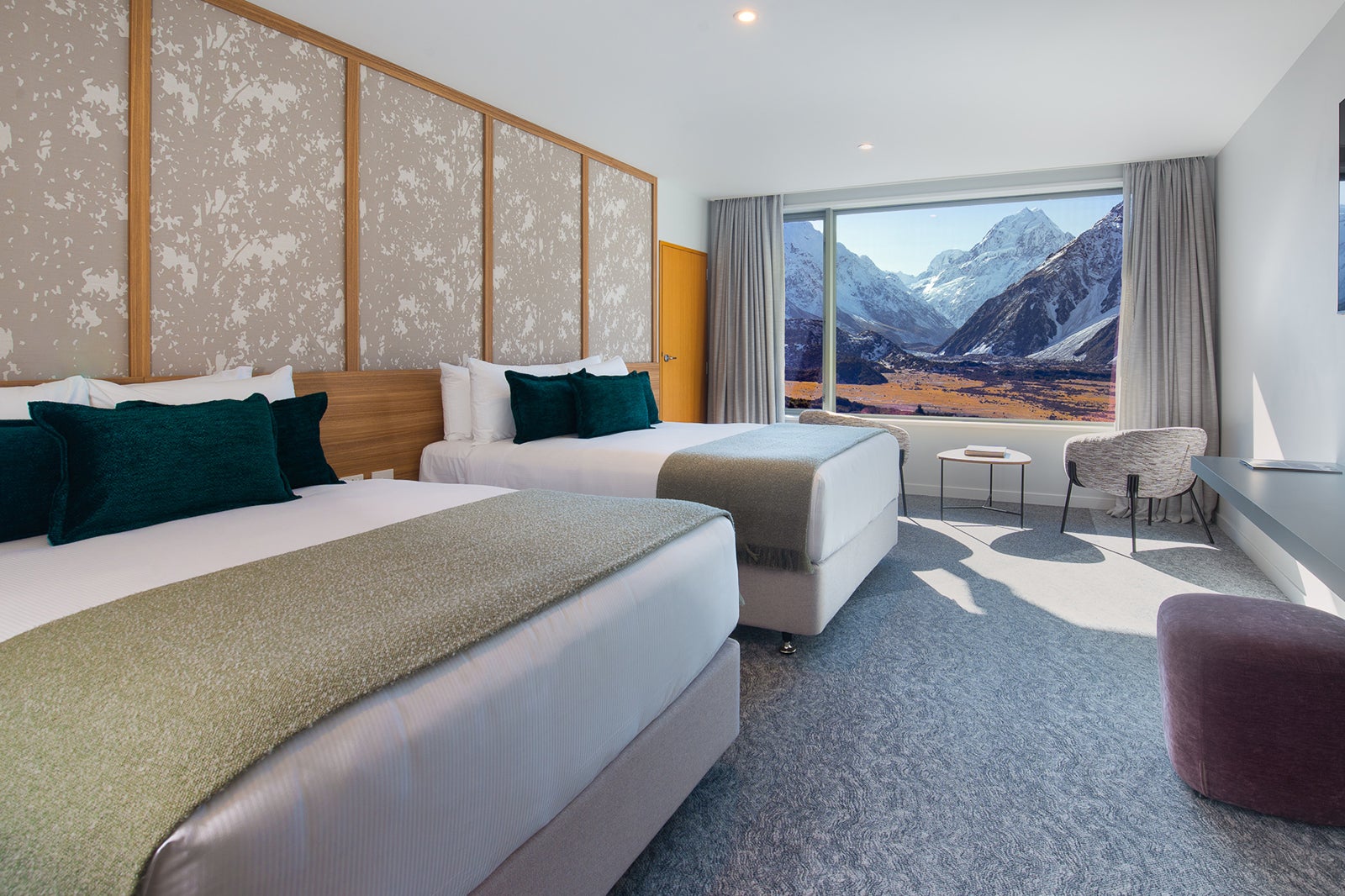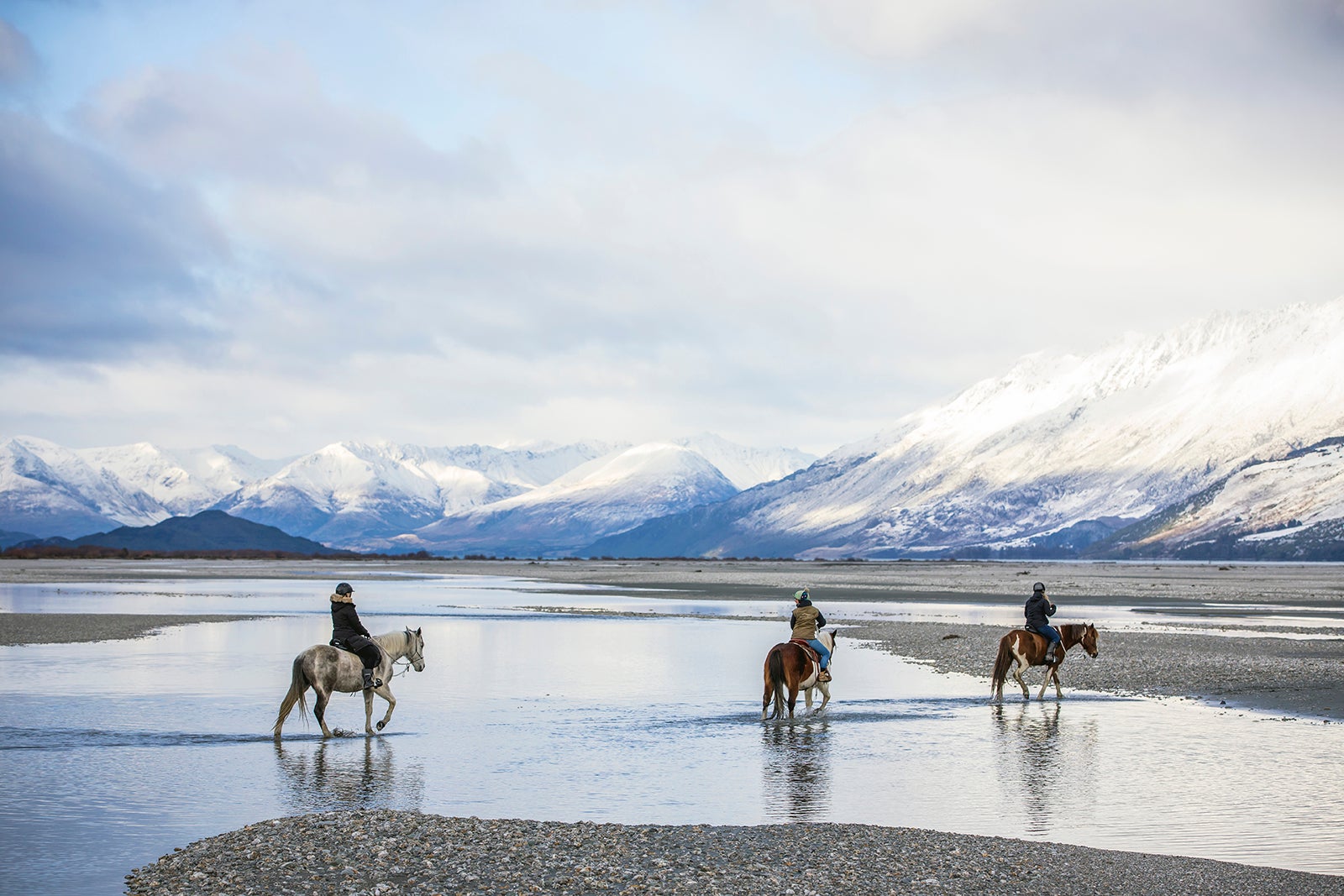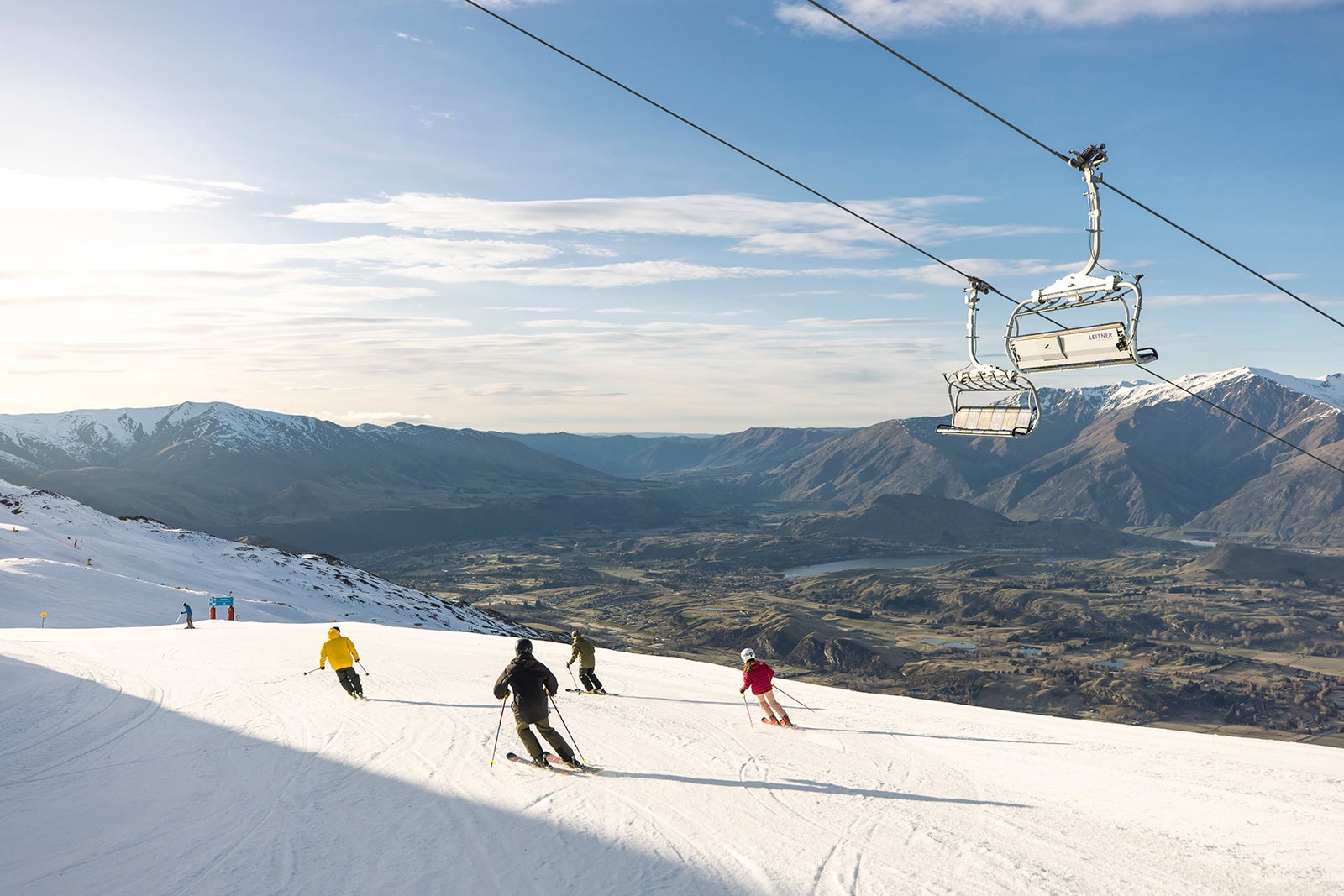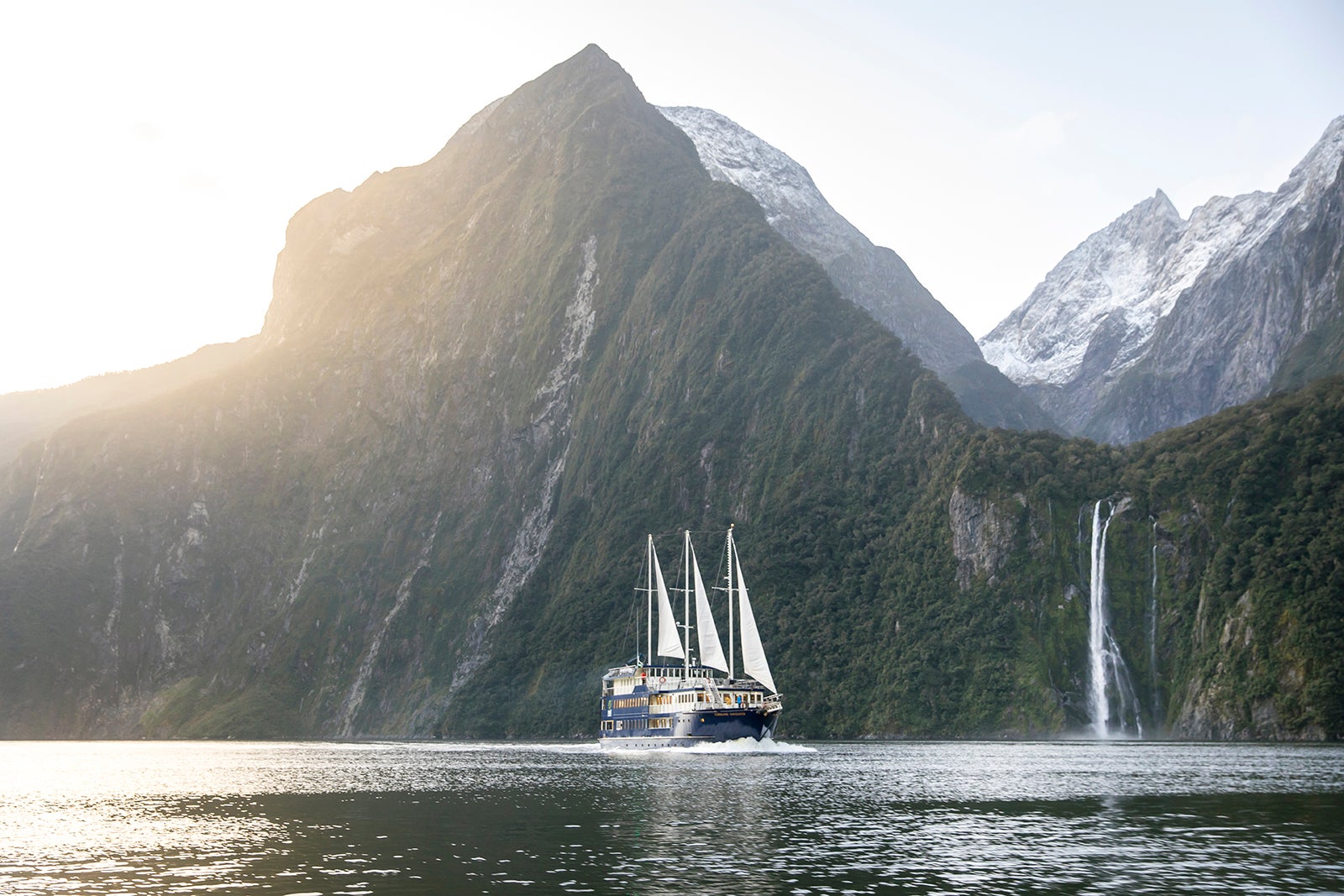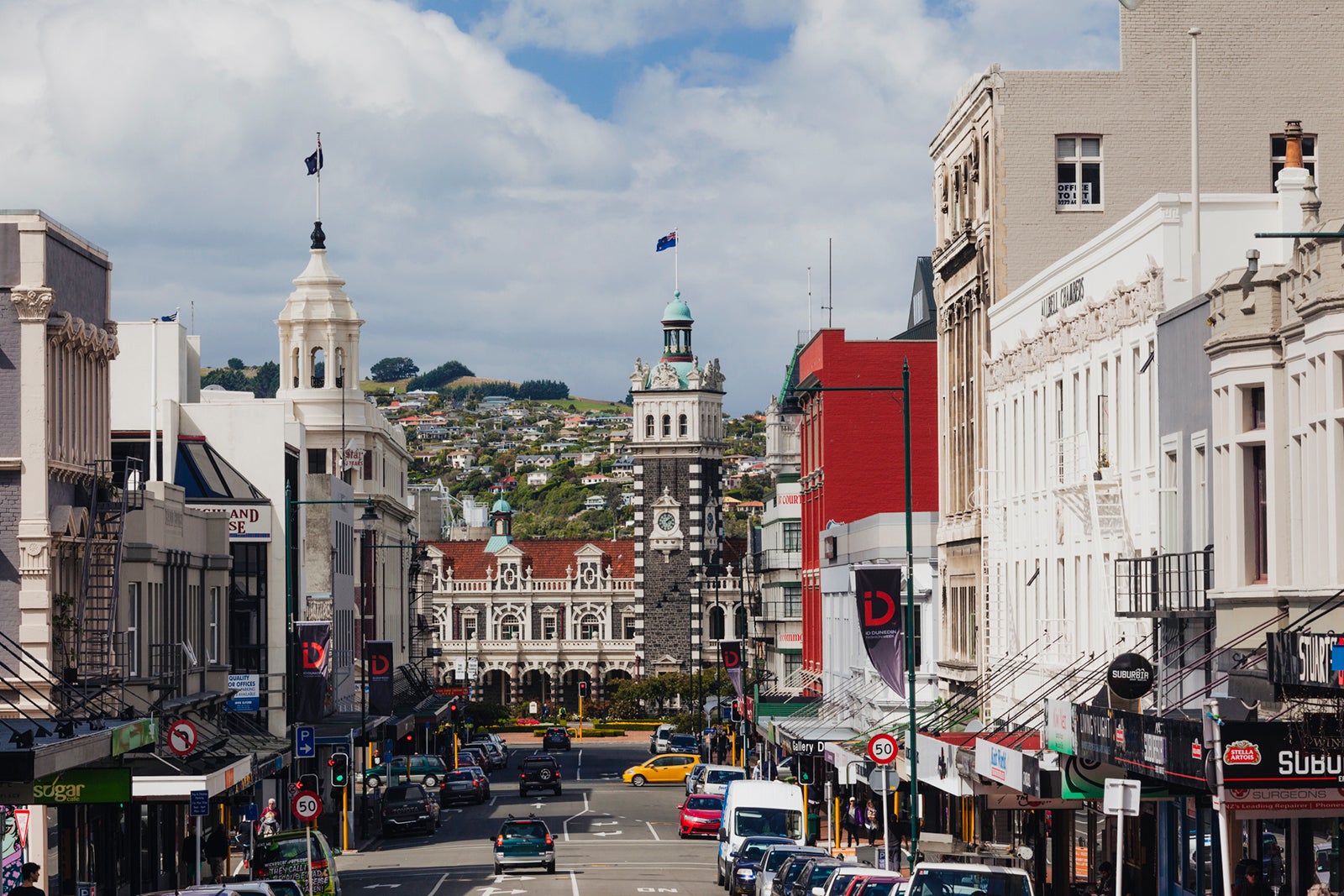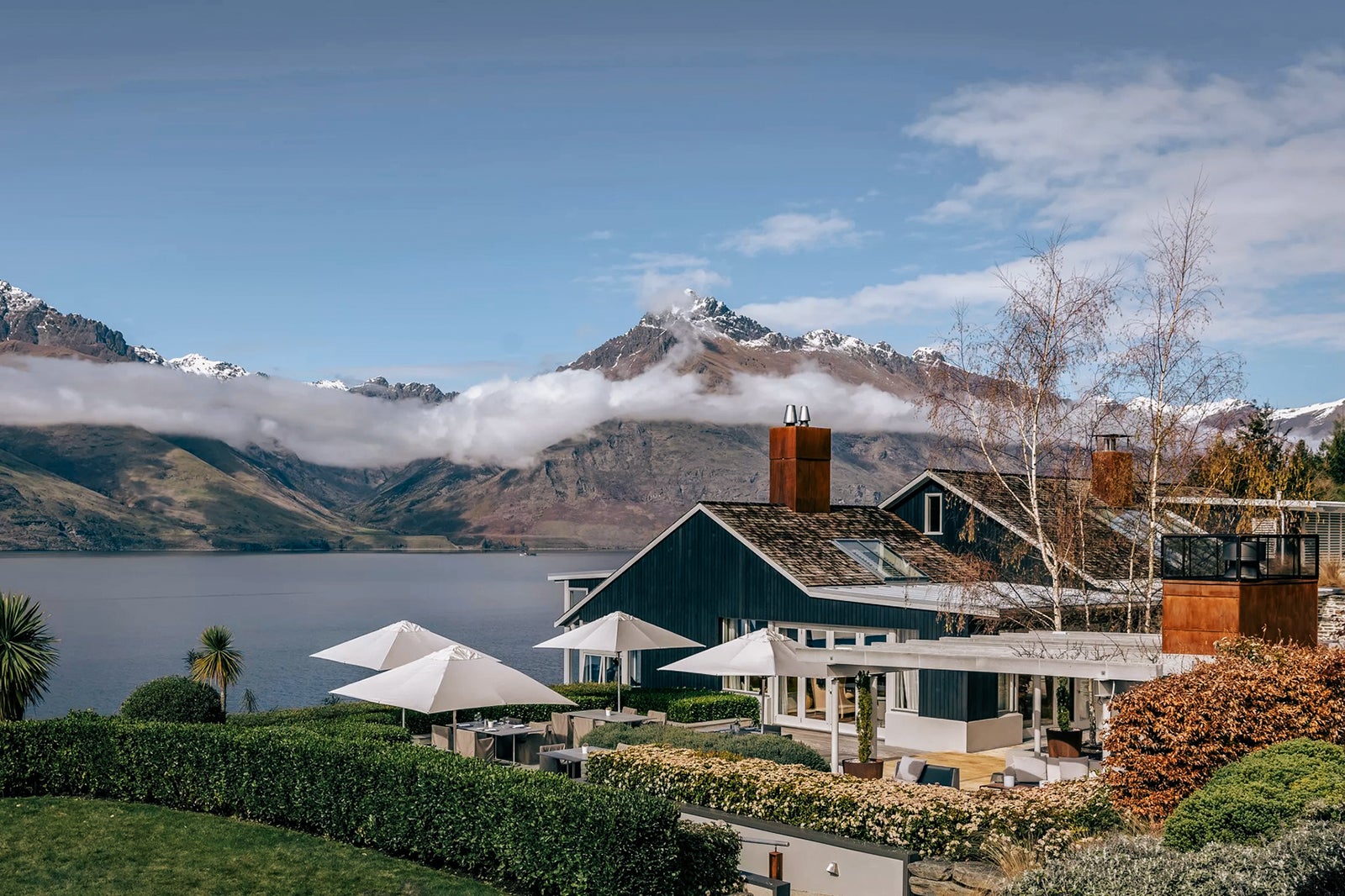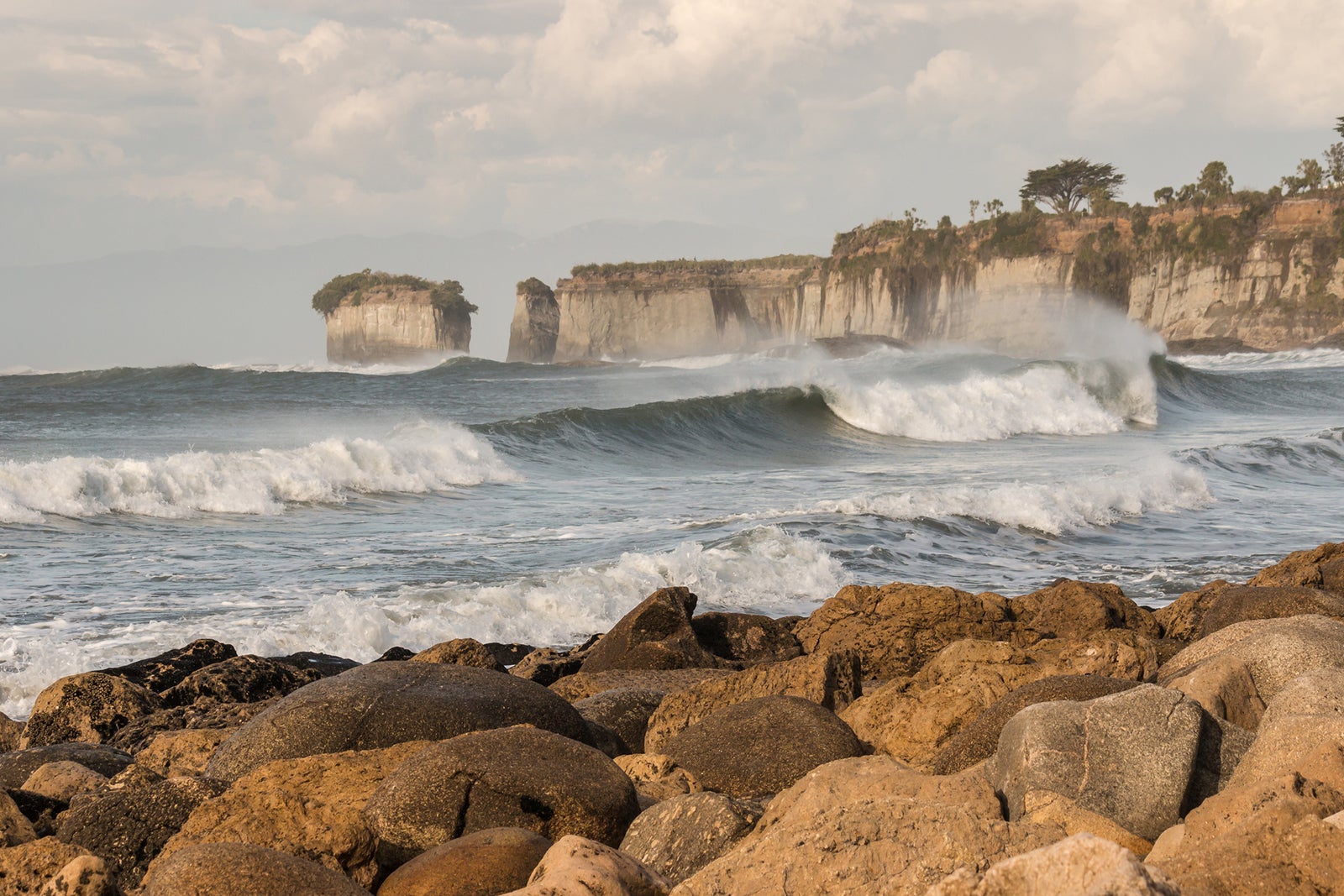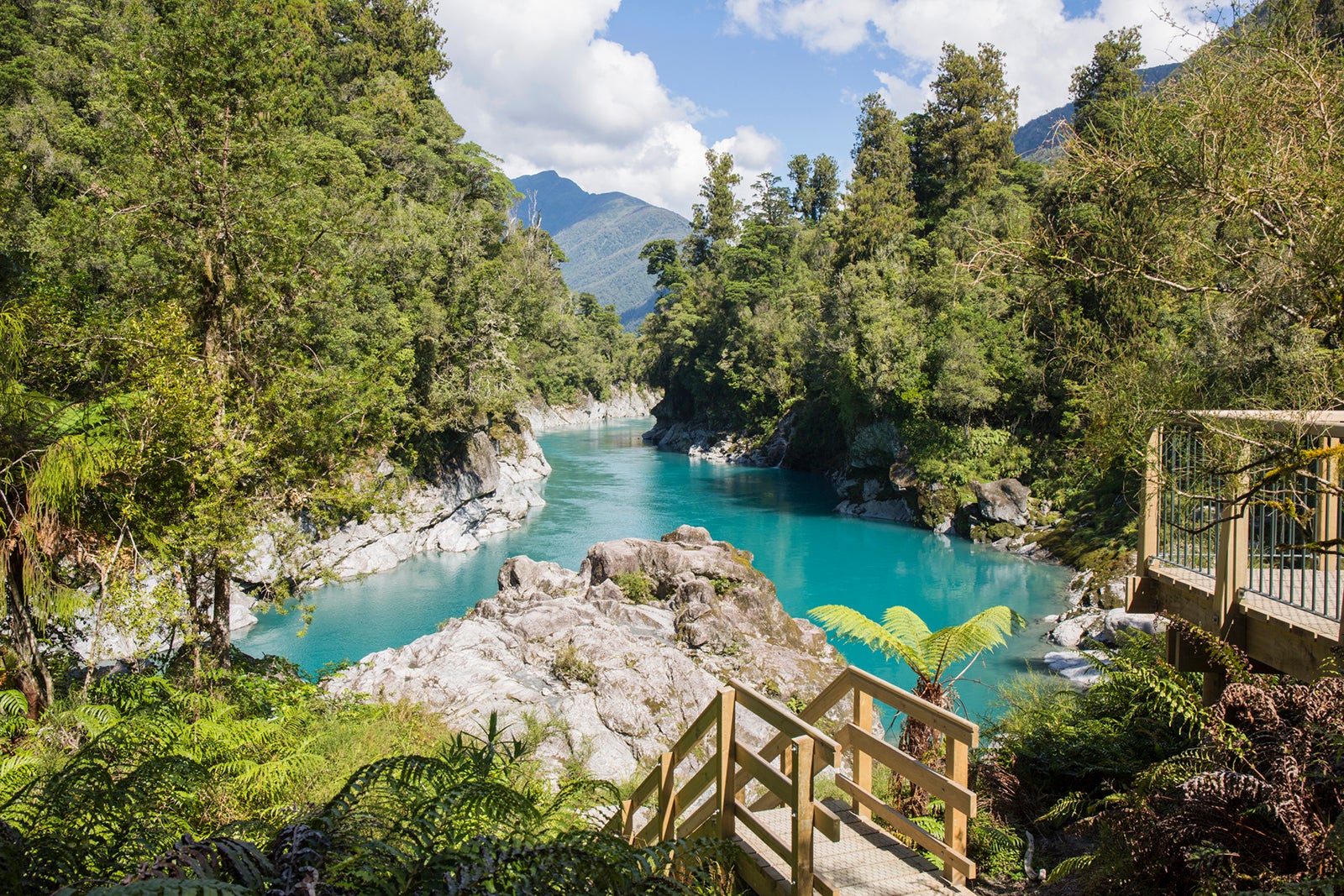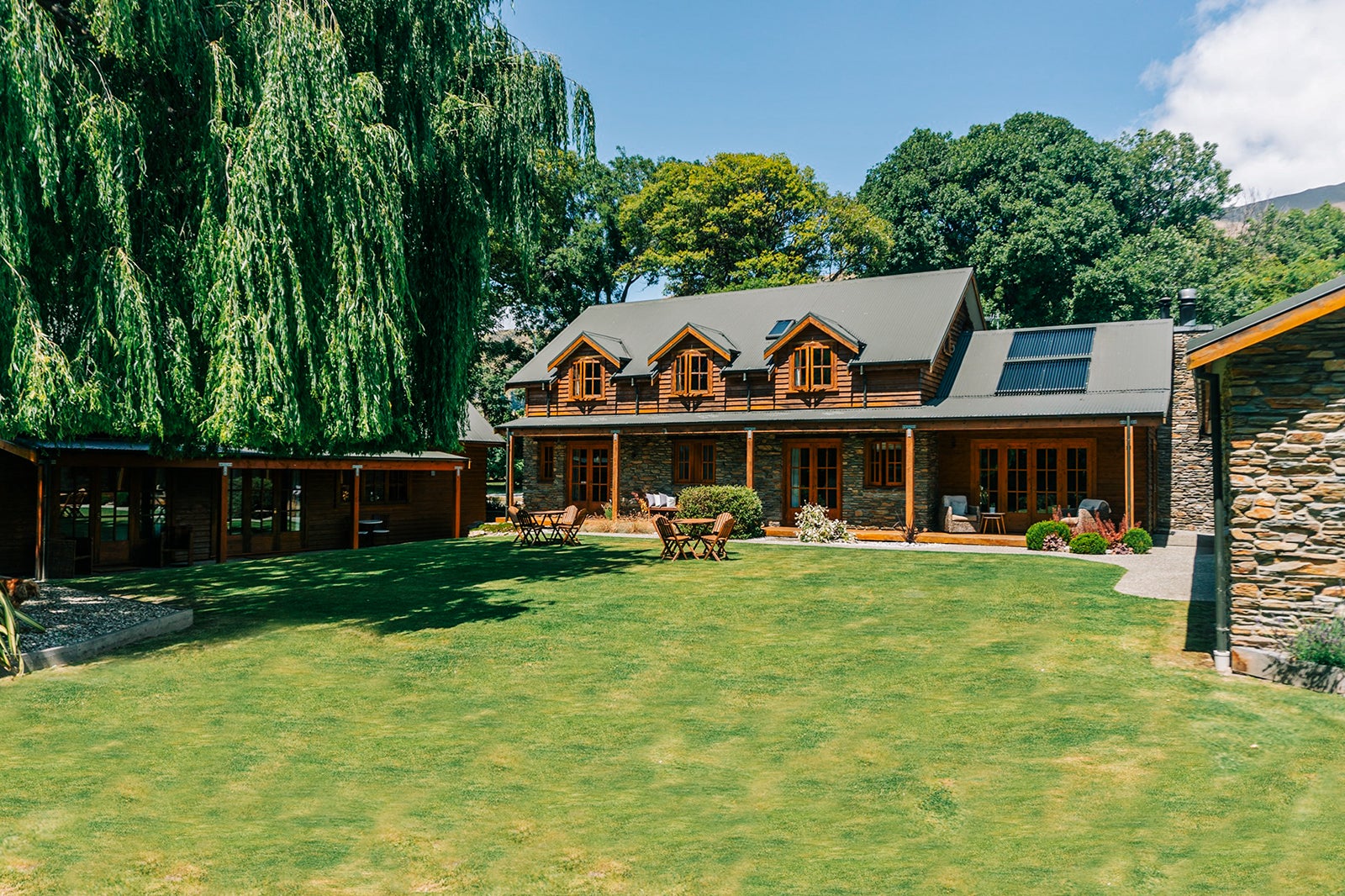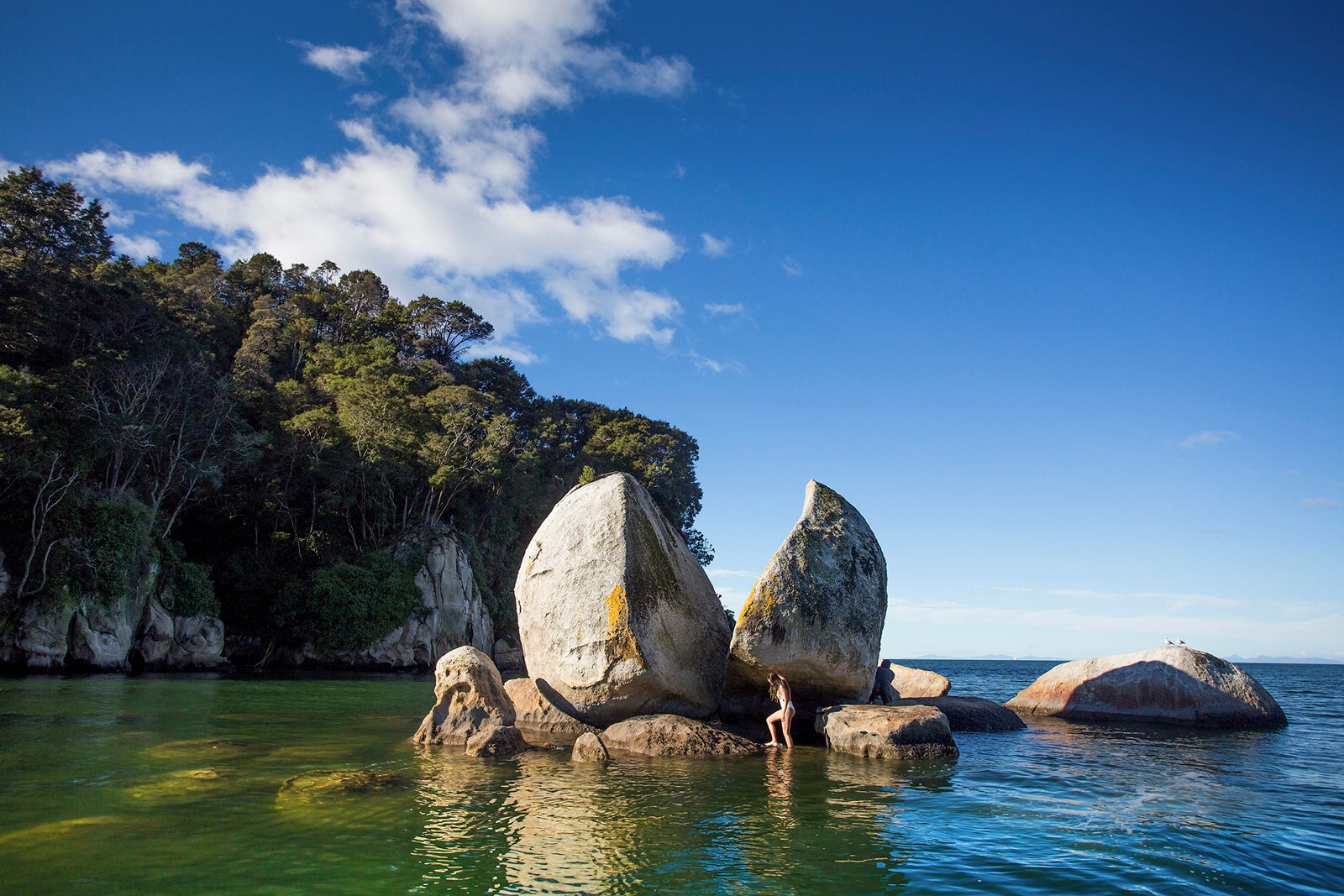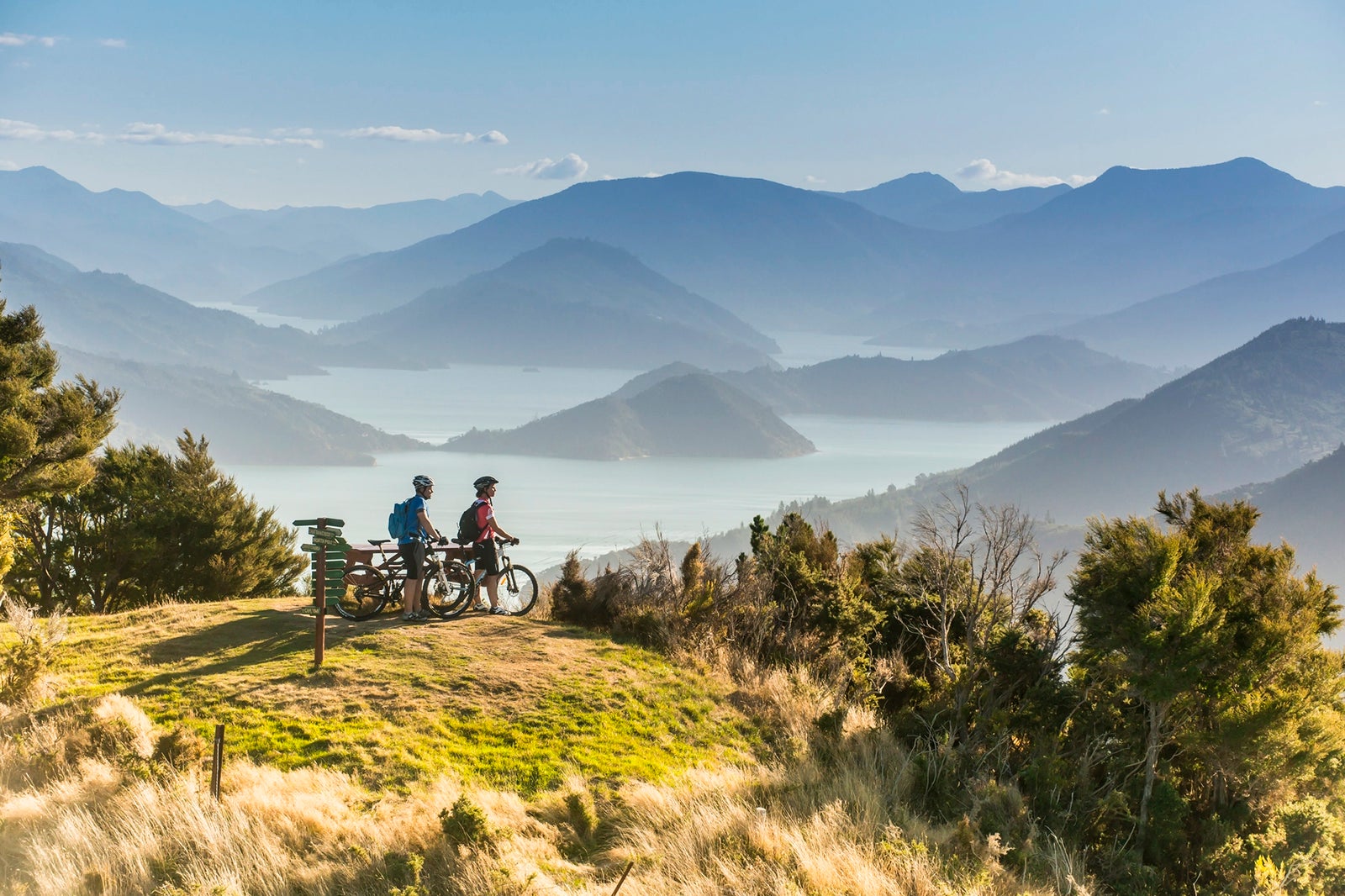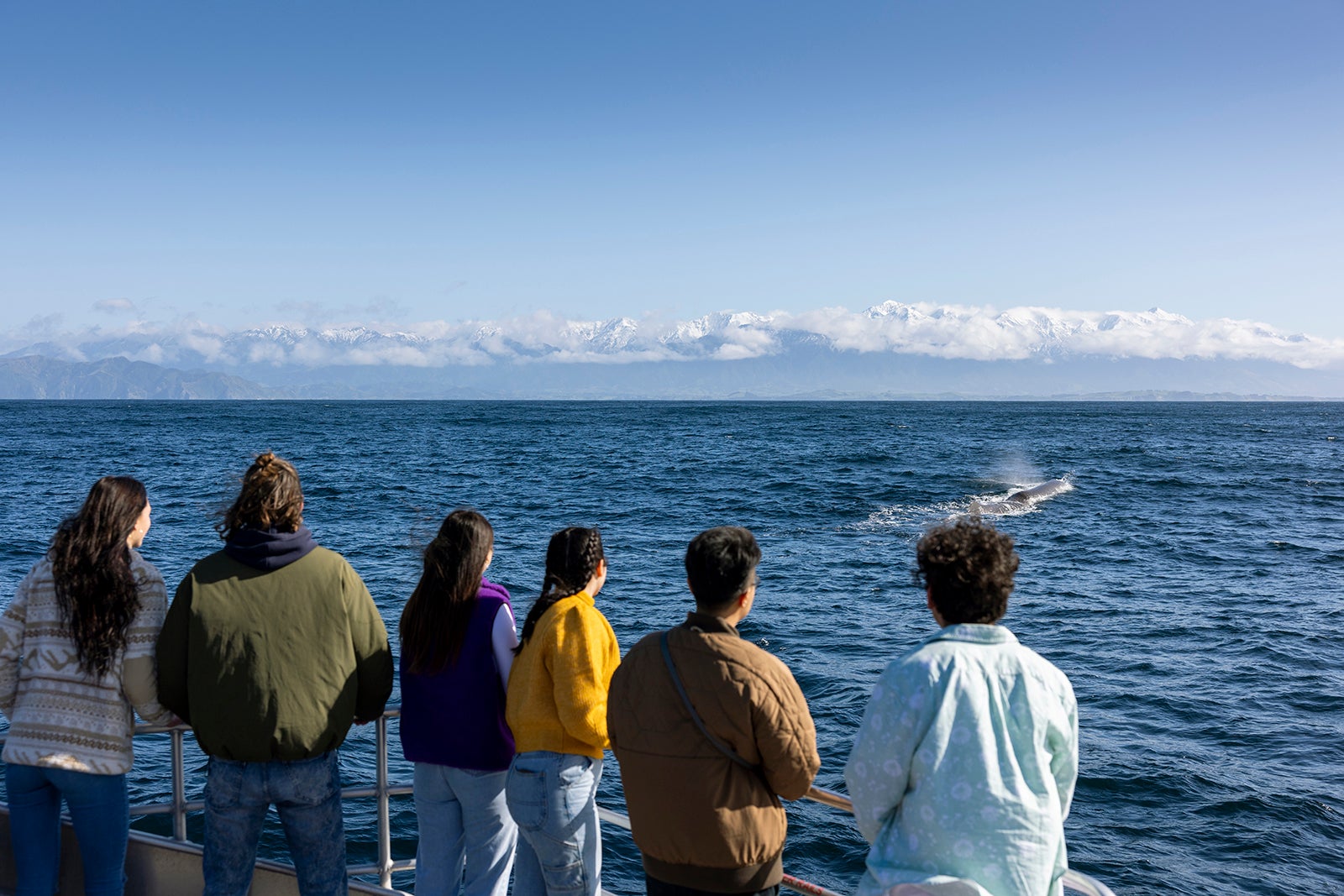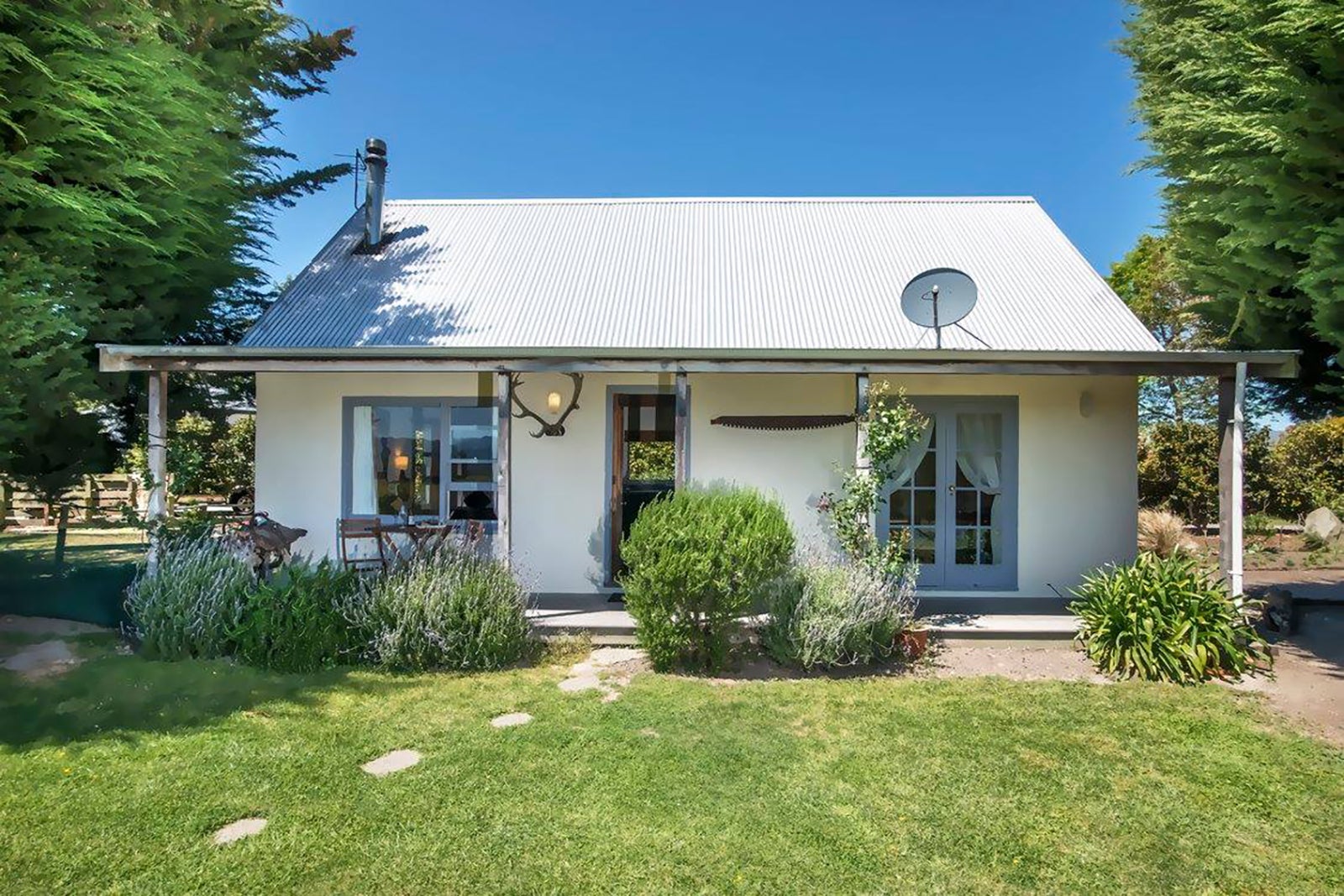Home to some of the world’s most iconic natural landscapes, New Zealand’s South Island—or Te Waipounamu, in New Zealand’s Indigenous Maori language—offers a dazzling array of visual wonders. Although it is about about 25% larger than New Zealand’s North Island, it’s home to less than a quarter of the country’s population.
This rural character results in less car traffic, commercial development and crowds (of people, anyway — you will see plenty of fuzzy sheep). Brilliant blue-green lakes, undulating emerald hills, craggy coastal headlands, utterly pristine beaches and soaring glacier-covered peaks dominate the landscape depending on where you are. And the region’s unhurried pace imbues it with a friendly, easygoing atmosphere.
Driving fully around the South Island is a bucket list experience for fans of road-tripping. Even if you’re unused to it, you’ll likely find it quite easy to get the hang of left-side driving after a day or two, and exploring by car makes it possible to discover the many remote parts of the island at whatever pace suits you.
The greatest challenge you may face is simply figuring out how to pack so much incredible scenery into one trip. Of New Zealand’s 13 national parks, all but three are on the South Island. And beyond the incredible opportunities for exploring the wilderness, the island offers plenty in the way of art, culture, food and wine. Here’s how to plan an incredible road trip through New Zealand’s South Island, including highlights along the way.
New Zealand South Island road trip planning
Perhaps the most useful thing to remind yourself when planning a tour of the South Island of New Zealand is that you’re going to see incredible natural scenery no matter how much ground you cover, so try not to get too anxious about attempting to see every single famous point of interest.
Set aside enough time
Although the South Island is only about the size of the state of Georgia, it will take most folks a minimum of two weeks to fully circumnavigate it. It’s traversed by rugged, twisting roads, and it abounds with stunning scenery that you will want to enjoy at a leisurely pace. That said, it’s possible to undertake an abbreviated but still spectacular portion of the itinerary described in this story in as little as five days, and you can see the island’s most rewarding regions in about 10 days.
Getting to New Zealand’s South Island
Most international flights to New Zealand arrive at Auckland Airport (AKL) on the North Island. Notable exceptions are those from Australia; there is nonstop service from several cities to Christchurch and Queenstown.
Assuming you are flying into Auckland, though, you can catch ongoing Air New Zealand or Jetstar flights to South Island destinations including Christchurch and Nelson, the starting and end points of this particular itinerary. Flights are plentiful and start at about 75 New Zealand dollars ($45) each way.
If you plan to tour both islands by car, however, you could rent a vehicle in Auckland and explore the North Island, then head to the country’s capital, Wellington, and catch the 3 1/2-hour ferry from there to Picton, at the northern tip of the South Island. Although rental agencies allow you to take cars on the ferry, they do require you to return the car to the island where you rented it. You could potentially pick up a rental car in Auckland and bring it over to the South Island by ferry, but you’d need to return it to the North Island at the end of your trip. There are car rental agencies at both ferry terminals, though, so you could also take the ferry without a vehicle and rent cars on either side.

Daily Newsletter
Reward your inbox with the TPG Daily newsletter
Join over 700,000 readers for breaking news, in-depth guides and exclusive deals from TPG’s experts
Many car rental agencies charge only a small one-way drop-off fee or none at all, which allows you to start and end in different cities, which is a particular benefit for road trips like this.
Best starting and end points on New Zealand’s South Island
As one of the country’s main hubs, Christchurch is a great place to start and possibly end a South Island road trip. It’s also a friendly, dynamic and underrated city in its own right, worthy of spending at least a couple of days. In the interest of saving time, the itinerary in this article ends in Nelson, a small and sunny city with a great airport. Ending there allows you to spend some time exploring nearby Abel Tasman National Park and the wine country of Marlborough without having to make the six-hour drive back to Christchurch. If you have a few extra days, however, you could drive down the Kaikoura Coast to end your trip back in Christchurch, potentially tacking on an overnight in the resort town of Kaikoura along the way.
If you’re making a full circuit of the South Island, you could start and end in pretty much any city with regular flights to Auckland. Queenstown is a popular choice, but rental cars and hotels there tend to be quite expensive, which may significantly affect the cost of your trip. Dunedin, at the south end of the island, is another good place to start and end a full circumnavigation of the island, as is Nelson at the island’s north end.
Renting a car vs. a camper van in New Zealand
Most major car rental agencies have offices at the airports in Christchurch and Queenstown, and many smaller airports around the South Island have branches as well. Rental prices can vary a lot depending on the agency (local ones can be significantly cheaper) and the time of year you’re traveling, so it’s worth shopping around. And again, one-way drop-off fees are relatively reasonable in New Zealand.
It makes sense to rent a conventional vehicle if you’re staying in hotels and vacation rentals, but do consider spending a little extra for an SUV, as South Island roads can be rugged in some of the more remote areas, including the national parks, and even a compact SUV is preferable to a standard passenger car thanks to its higher clearance and sporty handling. Rates typically range from about NZ$250 ($150) to NZ$450 ($270) per week for an SUV.
RVing is extremely popular in New Zealand, however, and this option can be a great fit if you intend to overnight in campgrounds and in more secluded areas. Several companies — including Jucy, Euro Campers and Britz — rent camper vans or small RVs. It is advisable to rent a smaller camper van to better maneuver the South Island’s many windy and narrow roads. Rates for these vehicles vary considerably, depending on their size and amenities, but you can expect to pay from NZD$350 ($210) to NZ$1,200 ($725) per week.
Keep in mind that gas stations can be few and far between, and also quite expensive, in less populous areas, including Fiordland National Park and much of the west coast. It’s a good idea to top off your tank in larger towns before setting out on a long drive.
The best time to visit New Zealand’s South Island
Summer through early fall (December through April) tends to offer the best weather on this island known for its somewhat fickle climate, especially in Fiordland National Park and the mountainous and untamed west coast.
Realistically, no matter when you visit, you’ll probably encounter rain on at least some days as well as a wide range of temperatures, so pack for a variety of conditions and dress in layers, some of which should be waterproof. Hotels, tours and some other services cost more in summer, especially during the peak holiday season from mid-December to the beginning of January.
Late summer and early autumn, from mid-February through April, offers the best odds of sunny skies. As you move deeper into autumn, there’s also the added promise of encountering colorful fall foliage. Although spring (September through November) can be wet, it’s also a lush time for hikes to waterfalls and across wildflower-dotted meadows.
Winter on the South Island has its charms, too, though. Temperatures still usually creep up into the mid-50s in Christchurch, Nelson and other coastal areas on the upper half of the island. Meanwhile, Queenstown morphs into a popular skiing and snowboarding destination.
Start your road trip in Christchurch
The South Island’s largest city (population 382,000) is an underrated gem that some visitors skip over in their hurry to reach the region’s many national parks. Don’t make the mistake of giving short shrift to this friendly center of culture and gastronomy, though, since it also boasts plenty of nearby opportunities for visiting gorgeous natural scenery.
Although it was devastated by a 6.3 magnitude earthquake in 2011 that destroyed or damaged hundreds of buildings, Christchurch once again feels vibrant, with dozens of striking new contemporary buildings, many of them sporting colorful and creative murals.
Most of the city’s notable hotels are in the compact, pedestrian- and bike-friendly city center, making it an easy hop to leading attractions like the curving glass-sheathed Christchurch Art Gallery Te Puna o Waiwhetu, the history-rich Canterbury Museum and verdant Hagley Park, through which the tranquil, tree-lined Avon River meanders. This 410-acre swath of greenery is a delight. Walk by the poignant Canterbury Earthquake National Memorial, a tribute to the 185 people who lost their lives in the 2011 earthquake, and pass some time in the park’s lushly landscaped Christchurch Botanic Gardens. If it’s a nice day, go punting on the Avon River, which curves through the park and downtown; these guided half-hour boat tours are great fun.
The regal Gothic campus of Christ’s College fringes the park and the western edge of downtown and is pleasant to walk through. Among a growing number of food halls in Christchurch, Riverside Market is a lively two-story hall packed with excellent eateries proffering first-rate Indonesian, Japanese, Greek and other international fare. You’ll also find first-rate craft beer and coffee vendors, and there’s outdoor seating under a grove of trees overlooking the Avon River. Foodies could easily pass several days in town trying out the sensational eateries, everything from the hip cafe Grizzly Baked Goods (start the day with an eggy breakfast bagel) to the sumptuous dining room at Otahuna Lodge, a gracious Relais & Chateaux boutique hotel about 10 miles south of downtown.
One of the prettiest spots along the jagged coastline near Christchurch is the Banks Peninsula, which is a little over an hour’s drive southeast. Even if you’re short on time, set aside a half-day to visit the breathtaking bayside hamlet of Akaroa, set along the edge of a sunken volcanic cone. Go for a short hike out onto the Onawe Peninsula, savor a leisurely lunch at Ma Maison or The Common (this cheerful town with French roots has several appealing spots for a meal), and follow Summit Road (look for signs for Tourist Drive) on your way out of town, as the ocean and harbor views from the jade-green hills are stupendous.
Where to stay near Christchurch
The plush rooms at The Mayfair (rates start at NZ$299/$180 per night) feel especially worth paying a premium if you’re arriving after having flown a long way to New Zealand. Rooms at this chic, contemporary hotel have floor-to-ceiling windows, sumptuous linens and Byredo bath products.
With a convenient central location, Quest on Manchester (rates start at NZ$249/$150 per night) has large, modern, apartment-style suites with well-equipped kitchens. Foodies should gravitate outside town to Otahuna Lodge (from $1,450 per night), a historic former private mansion that has been converted into one of the country’s top luxury lodges and that boasts landmark gardens that have been painstakingly restored.
Lake Tekapo and Aoraki-Mount Cook National Park
Although famed for being the home of New Zealand’s highest peak and a must-visit on any South Island automotive tour, Aoraki-Mount Cook National Park and the neighboring Mackenzie Basin can be appreciated in just a couple of days.
This region, made up mostly of alpine wilderness and vast meadows, is sparsely populated and contains just enough infrastructure to provide comfortable accommodations and dining options for tourists passing through. Most visitors spend a night or two in Aoraki-Mount Cook Village (the best choice if you’re planning extensive hikes), or in either Lake Tekapo or Twizel, which are near enough to serve as base camps for visiting the park.
Allow about three hours to drive from Christchurch to Lake Tekapo via highways 1, 79 and 8, and another 45 minutes to reach Twizel. These towns are just a glorious 45- to 75-minute drive along the west shore of turquoise-hued Lake Pukaki to get into the heart of Aoraki-Mount Cook National Park.
As you enter Lake Tekapo, pull off near where Highway 8 passes the lake’s southern shore to take in the astonishing views. The iconic photo op here is the small stone Church of the Good Shepherd chapel, set on a lonely (if you can capture it without any tourists photo-bombing your view) bluff overlooking the glacial lake. If you have time, make the short drive up around the southwestern side of the lake to Tekapo Springs to soak in one of the several geothermal pools set on a terrace overlooking the lake, and continue to the University of Canterbury Mt. John Observatory, which has an observation point with panoramic vistas; nighttime stargazing programs are offered here as well.
From just outside Twizel, follow Highway 80 along Lake Pukaki’s shore, stopping for a bowl of lavender-blueberry ice cream or to browse the myriad soaps, oils and other fragrant products at NZ Alpine Lavender Farm.
Some 30 miles later, when you arrive in the small town of Aoraki-Mount Cook, first visit the well-designed park visitor center in the middle of the village. It contains two floors of illuminating exhibits on the park’s natural and human history — everything from how Sir Edmund Hillary trained here on the country’s highest peak (elevation 12,218 feet) before summiting Mount Everest to information about both native (like kea birds) and introduced fauna (possums, wild goat-like tahrs, stoats and more). The best all-around hike for visitors is the 3-mile there-and-back Hooker Valley Track, a relatively level walk that traverses a glacial valley to a shimmering alpine lake. There are several shorter trails emanating from the same parking area, which does fill up fast on nice days. Consider going very early (arriving before 9 a.m. if possible) or late in the afternoon to avoid the throngs of fellow trekkers.
Where to stay
Situated right inside the national park, the Hermitage (rates start at NZ$315/$190 per night) is a classic mid-20th-century park lodge with unfussy guest rooms, many with prime views of the park’s spectacular Tasman Valley. The main reason to stay here is convenience to the park; a number of guest experiences are available, from astronomy shows to helicopter tours and glacier landings.
In Lake Tekapo, Grand Suites Lake Tekapo (rates start at NZ$495/$300 per night) opened in 2022 and offers some of the swankiest rooms in the region. Just outside Twizel, comfortable Pukaki Air Lodge (rates start at NZ$225/$135 per night) has dramatic views of the surrounding countryside and is adjacent to a tiny regional airport, so in the morning, you can watch private planes and helicopters taking off next door.
Right in the center of Twizel, the reasonably priced Lakes Motel (rates start at NZ$190/$115 per night) has pleasant, roomy accommodations close to the area’s best (albeit still a bit limited) selection of restaurants, as well as a well-stocked supermarket.
Twizel to Queenstown
Give yourself about three hours to make this drive south on Highway 8, potentially stopping briefly to photograph the brilliant aquamarine waters at Lake Ruataniwha View Point and for an hour or two to scamper amid the towering rock formations of Clay Cliffs, near Omarama.
As you enter the Otago region, the road climbs dramatically over the arid, almost desertlike hills of 3,186-foot-elevation Lindis Pass before dropping down along the eastern shore of Lake Dunstan and passing through Cromwell, a historic town with a handful of attractions that relate to its heritage as a Victorian-era gold-mining town.
This is also the heart of the prestigious Otago wine region, so budget time for tasting at one or two of the popular cellar doors (as tasting rooms are known in New Zealand and Australia). Worthy stops for sipping the region’s acclaimed pinot noir (and to a lesser extent pinot gris and chardonnay) include Mt. Difficulty Wines, Te Kano Estate and Domain Road Vineyard. In Cromwell, pick up Highway 6 for the final 45 minutes to Queenstown.
Queenstown
With a postcard-worthy setting at a sharp bend on long and curvy Lake Wakatipu, this see-and-be-seen playground of outdoor recreation is framed by the snowcapped peaks of the Southern Alps and has boomed over the past 25 years … to a population of a mere 30,000, though visitors often outnumber residents.
It’s home to some of the most expensive hotels on the South Island, especially for rooms with lake and mountain views. The attractive lakefront city center abounds with stellar eateries and snazzy nightspots where travelers can talk over the day’s adventures. Parking can be challenging and restaurant reservations are highly advisable, with Amisfield, Nest Kitchen and Blue Kanu ranking among the area’s top tables.
Extreme sports are Queenstown’s calling card, and you can find outfitters offering any number of adrenaline-fueled activities, including tandem skydiving, whitewater rafting and bungee jumping. Queenstown is also a popular jumping-off point for forays into New Zealand’s iconic Fiordland National Park, whose magnificent Milford Sound fjord lies just 40 miles away as the crow (or helicopter) flies, but about 180 miles by car.
You could make Queenstown your base for several days of outdoor fun, indulgent pampering or both. As a shorter stop on a South Island road trip, you can get a feel for Queenstown in a day or two, and if you prefer a mellower vibe away from the crowds, you might want to stay in low-key and charming Arrowtown, just a 20-minute drive northeast.
Arrowtown
This quaint mountain hamlet near Queenstown boasts an adorable, compact downtown lined with heritage buildings that house stylish boutiques and restaurants. Set aside at least a couple of hours to drop by for lunch or dinner at the stellar Postmasters Kitchen + Bar or the hip mod Italian trattoria Aosta, and to walk through Arrowtown Chinese Settlement, a historical park that preserves the place where Chinese immigrants settled in the 1860s during the region’s gold rush era.
Fiordland National Park
It takes time and effort to get into the heart of Fiordland National Park, a nearly 5,000-square-mile tract of soaring peaks and breathtaking waterways (it’s the largest of the country’s 13 national parks). Be skeptical of anyone who says you could skip this park if you’re touring the South Island and are short on time. At a minimum, it’s absolutely worth setting aside a long day to take a cruise around the park’s most iconic attraction, Milford Sound. Yes, you’ll encounter throngs of fellow tourists cruising around this deep fjord flanked by steep, mile-high slopes, and you may encounter inclement weather, but you’ll be glad you came, even on the rainiest day.
Numerous tour companies offer trips to the boat terminal at Milford Sound that include bus transportation from Queenstown (a four-hour drive each way) or from the town of Te Anau, which is just under a two-hour drive. From Queenstown, you can also spring for a helicopter ride to the terminal if it’s in your budget. The flight takes 40 minutes each way and includes mesmerizing scenery the entire way.
The bus option provides you with the chance to sit back, relax and let others do the driving. But if you don’t love being herded around with a big group, it can make sense to drive yourself to Milford Sound. Just keep a few important points in mind. From Queenstown to Milford Sound and back, it’s a long day, with eight or nine hours spent driving, two hours for the boat cruise around the sound, and another hour or two for stops along the way. The excellent outfitter Southern Discoveries offers some of the best Milford Sound cruises. Do yourself a favor and skip paying for the underwhelming food served on board and bring your own lunch. You can pick up tasty sandwiches, coffees and sweets at Sandfly Cafe in Te Anau. The drive from Queenstown, though long, is gorgeous, especially once you enter the park.
You can also greatly reduce the time spent driving in a single day by spending one or two nights in Te Anau, a laid-back lakefront village about midway between Queenstown and Milford Sound that serves as a comfortable base with several lodgings as well as the excellent Fiordland National Park Visitor Centre.
Wherever you begin the day, give yourself extra time to get to the boat terminal and plan to arrive at least an hour before your cruise departs. Parking can be hard to find in the lots nearest to the terminal, and construction and bus traffic on the park road can cause delays. There are a number of scenic turnouts along the park highway, but it’s best to save these for the drive back to Te Anau or Queenstown, when you’re not racing to make it to the terminal.
Optional side trip to Dunedin and Invercargill
If you’re able to tack on an extra couple of days to your South Island adventure, consider making the roughly four-hour drive from Queenstown southeast to Dunedin, a stately city of around 130,000 souls that’s anchored by the prestigious University of Otago and enjoys a splendid location on the Island’s southeastern coast.
Dunedin is notable for being a UNESCO City of Literature, and it boasts several prominent attractions, among them Larnach Castle & Gardens; Toitu Otago Settlers Museum; the OPERA (Otago Peninsula Eco Restoration Alliance), where you can view endangered yellow-eyed penguins; and the Royal Albatross Centre, another remarkable nature preserve. The latter two spots are on the sweeping Otago Peninsula.
From Dunedin, continue down Highway 1 to Invercargill and the small town of Bluff, at the South Island’s very extreme southern tip. This drive is part of the famously beautiful Scenic Southern Route. From Invercargill, it’s a 2 1/2-hour drive due north back to Queenstown on Highway 6. This drive can easily be combined with going to Fiordland National Park, the turnoff to which is along this route.
Where to stay
Among Queenstown’s numerous posh accommodations, the elegant Rosewood Matakauri (rates start at NZ$3,048/$1,835 per night) is perhaps the most splurge-worthy, with its enchanting lakefront setting, exquisitely appointed villas, and top-class amenities and dining. Close to town, the Rees Hotel (rates start at NZ$588/$353 per night) offers attractive suites with smashing lake vistas, in-room spa services, a sophisticated wine bar and a private beach. A short drive from Queenstown, the intimate Arrowtown House Boutique Hotel (rates start at NZ$487/$293 per night) is a short walk from this heritage town’s bounty of fine shops and eateries. Rates include a phenomenal cooked-to-order breakfast, and a bottle of wine and cheese plate upon arrival. In Te Anau, Radfords on the Lake (rates start at NZ$599/$360 per night) offers plush accommodations with views of the lake and the rugged mountains of neighboring Fiordland National Park.
Queenstown to Westport
You can make the drive up the South Island’s minimally populated and stunning west coast comfortably in a couple of days, but consider tacking on a third day if you wish for a bit more time to relax and explore the sights along the way, which include two famous, though rapidly receding, glaciers and several scenic beaches and lakes. A good plan is to spend your first night around Fox and Franz Josef glaciers, and your second night in the popular vacation town of Hokitika or farther north up the coast in Westport.
Wanaka
There are two main routes for getting from Queenstown to this lake town about 45 miles north. The prettiest is via the Crown Range and Cardrona Valley roads, a route that begins at Arrow Junction with a steep climb up a series of switchbacks. Pause at one of the parking areas for a spectacular view back toward Queenstown and the surrounding lakes and mountains. If you’re hungry, stop in tiny Cardrona at the funky roadhouse-style pub inside the historic Cardrona Hotel. Once you get to Wanaka, head downtown to the shoreline along the southern end of dazzling Lake Wanaka. Wanaka Station Park offers beautiful scenery, a view of the oft-photographed Wanaka tree, and paths through other towering trees. There are several excellent restaurants in town, and B.Effect Brewing is a great place to grab a craft beer or kombucha.
Continue up Highway 6 along the western shore of what some claim is the most magnificent lake on the South Island, Lake Hawea. The highway then curves along the upper shore of Lake Wanaka before winding alongside the Haast River and out to the ocean at the small, laid-back town of Haast. A 20-minute drive farther up the coast, Knights Point Lookout is an excellent spot to hop out for a bit of beachcombing. This is also the first place where many visitors to the west coast first encounter the island’s unofficial nuisance, the sand fly. These pesky critters quickly swarm and bite, so definitely keep insect repellent (anything containing DEET works well) on hand.
Fox Glacier and Franz Josef Glacier
About 60 miles up the coast from Knights Point, Highway 6 reaches the first of two towns named for the natural features that made them famous.
Fox Glacier lies at the base of a lush river valley at the edge of Westland Tai Poutini National Park, which is adjacent to Aoraki-Mount Cook National Park. On clear days, you can even see the country’s highest peak, which is only about 16 miles south.
Although one of the main reasons to visit this town is to view the glacier, which you can do on the easy 1.6-mile round-trip Fox Glacier Valley Walk, you could also save your up-close glacier-glimpsing for Franz Josef and instead spend a half-day in Fox Glacier driving west to beautiful Gillespies Beach. Along this route, you’ll come to a viewing area that offers a nice glimpse of the glacier in the distance. This road also accesses the true highlight of this town, Lake Matheson, a small jewel that you can fully circumnavigate on foot in about 90 minutes via a flat trail. Be sure to go all the way to the end of the lake to the View of Views observation point, from which the lake and, beyond that, the valley of immense snowcapped peaks are framed.
Although Fox Valley has a handful of places to stay and eat, it makes sense to continue another half-hour or so up the coast to Franz Josef Glacier, which is larger and offers a better selection of restaurants and lodgings, along with a wide range of outfitters offering guided hikes, helicopter tours and other ways to engage with the impressive natural scenery.
It also affords the easiest access to a major glacier, as the hike from the parking lot to the viewing area along the Franz Josef Glacier Walk takes a mere 15 minutes. From this lot you can also access some longer treks into the surrounding natural beauty, including the popular Roberts Track, which takes about five hours round-trip but gets you much closer to the glacier. From town, allow a little under two hours to make the winding and relaxing drive farther up the coast to Hokitika.
Hokitika
This breezy, upbeat beach town is home to some of the best restaurants on the west coast and makes a great overnight base — or, at the very least, a stop for an enjoyable lunch. Arrive early if planning to eat at the famous Hokitika Sandwich Company, as supplies often run out early. But there are plenty of other nice spots to eat in town, including Thatcher & Small, a lively gastropub, and Hoki Boatshed Cafe for a perfectly frothed flat white.
The town is also notable for its many shops selling jewelry and crafts made from local jade, which is found on New Zealand’s west coast beaches. It’s worth going for a stroll around Sunset Point and the dramatic Shipwreck Memorial statue, overlooking the confluence of the Hokitika River and the sea.
One stop that’s great fun for getting an up-close look at the region’s wildlife is the National Kiwi Centre, where you can view these adorable flightless birds (they’re about the size of a large chicken) along with other primordial creatures, such as prodigious tuatara (lizards) and giant eels. One of the area’s most memorable attractions is Hokitika Gorge, reached by a pleasant half-hour drive. From the parking lot, it’s a short 20-minute walk over a sleek pedestrian suspension bridge that crosses an almost jarringly luminous turquoise-blue section of the Hokitika River.
Punakaiki
Continue up the coast along Highway 6 through the pleasant town of Greymouth, another potential overnight base. Then, another hour up a particularly dramatic stretch of road brings you to Punakaiki, a beautifully situated coastal village that’s the main base for visiting Paparoa National Park. Stop at the park’s visitor center, beside the parking area for the famed Pancakes Rocks and Blowhole Track. You can view this weirdly wonderful geological formation from a short and easy loop trail. It’s especially pretty late in the day, around sunset.
Also by the visitor center, the lively Pancake Rocks Cafe serves, you guessed it, bounteous stacks of pancakes from morning till dinner time along with tasty pizzas. Other features worth exploring in this area include Punakaiki Cavern and Beach, and the trail along the lush Pororari River, which is also popular for kayaking and stand-up paddleboarding (rentals are available in town).
Cape Foulwind and Westport
It’s a 45-minute drive farther up Highway 6 to the northernmost point along the west coast before most road-trippers turn inland and drive east toward Nelson. Here the cheerful beach town of Westport offers a convenient array of services and a few places to stay.
West Coast Pie Co. is a great stop for delicious meat pies with intriguing fillings like venison and goat, while PortSide Bistro is a good bet for a more substantial meal.
A little west of town in tiny Cape Foulwind, a beautiful coastal hike awaits. Follow the 4-mile round-trip Cape Foulwind Walkway past a stately lighthouse and then high along a bluff above a gorgeous, pristine beach and around to a viewing platform where you can watch the playfully swimming inhabitants of the Seal Colony at Tauranga Bay.
If you have an extra day in the area, before turning inland on Highway 6 you could venture farther north up the coast, via Highway 67, to explore one of the country’s more remote national parks, Kahurangi. A highlight here, which can be visited in a half-day from the Westport area, is the Oparara Basin Arches, a series of natural limestone tunnels along the Oparara River. The visitor center along the highway in the small town of Karamea is a good place to pick up more advice about what to see and do in this park.
Where to stay
If you want to tack on a night along the southern portion of this route, the Wanaka Homestead (rates start at NZ$280/$168 per night) offers five rooms and two cottages on a picturesque ski lodge-inspired property near the town’s famous lakefront.
Located right in the middle of friendly Franz Josef, within walking distance of several restaurants and the area’s best grocery store, Te Waonui Forest Retreat (rates start at NZ$420/$252 per night) makes an appealing base for exploring the area’s myriad opportunities for recreation and glacier-trekking. The luxurious rooms have terraces overlooking the verdant grounds, and there’s a full-service spa.
The historic Hokitika Fire Station Boutique Accommodation (rates start at NZ$360/$216 per night) contains five smartly retrofitted vacation apartments with patios, fireplaces and kitchens. It’s steps from the beach and Hokitika’s buzzy restaurants. Well-priced and with a blissfully peaceful location just outside Westport near the start of the Cape Foulwind Walkway hike, cute and light-filled Omau Settlers Lodge (rates start at NZ$169/$102 per night) has several attractive rooms, and there’s a convivial tavern next door serving well-prepared pub fare.
Westport to Nelson
From Westport, Highway 6 twists and turns in an easterly direction inland, through the scenic Buller River Valley. A little over an hour into the drive, the Buller Gorge Swingbridge is a popular, if a bit touristy, stop along the way. Here you can go zip-lining and jet-boating, and for a walk across the country’s longest swing bridge.
About 10 miles east in the easygoing town of Murchison, you can top off your gas tank and reenergize with good coffee and humongous muffins and pastries at Rivers Cafe. It’s just a 90-minute drive farther along Highway 6 to Nelson, but you could also detour north at the town of Kohatu to explore Abel Tasman National Park on your way. Just take Motueka Valley Highway for about 45 minutes north to the town of Motueka.
Nelson
The best base for exploring the northern end of the South Island, including Abel Tasman National Park and the Marlborough wine region, this balmy coastal city with nearly 60,000 residents is itself an enjoyable place to unwind and explore. It’s also a logical point to end your South Island road trip and catch a short flight to Wellington or Auckland. Spend at least a couple of nights here, and if you can, time your visit so that you can attend the bustling Nelson Saturday Market, with its vendors proffering local foods, art, jewelry, textiles and more. Food trucks here dispense a variety of delicious dishes, from artisan grilled cheese sandwiches to Asian food.
Nelson has a compact, walkable downtown and a pretty waterfront overlooking Tasman Bay. Nahm (for elegantly plated Thai food) and the Boat Shed Cafe (for local seafood) are delightful places to dine with a dazzling view of the water. Walking through leafy Branford Park and ascending the hill to the Centre of New Zealand Monument is a great way to take in the surrounding waterways and mountains. Other highlights in town include the Nelson Classic Car Museum and great swimming, family amusements and strolling on Tahunanui Beach.
Abel Tasman National Park
Home to some of the Island’s most pristine beaches, this 92-square-mile preserve of rolling seaside mountains is a wonderful place to idly chill out for an afternoon. If you’re up for a more ambitious adventure, consider booking a kayak tour out around breathtaking Golden Bay and several other tucked-away bays along the park’s shoreline. Companies renting kayaks also offer water taxi service to some of the best hiking areas in the park, most of which aren’t reachable by car.
If you’re just visiting for the day, head to one of the easily accessible stretches of sand, such as Kaiteriteri Beach, or — a bit farther afield but reached via a gorgeous drive — Totaranui Beach. You can make a quick hike to Wainui Falls along the way, and if you’re looking for a bite for lunch or dinner, stop in the cute town of Takaka. The Thai Food Nidtaya food truck is terrific. Just outside the park, on your way to and from Nelson, the town of Motueka is also a good bet for a meal and also has some appealing lodgings.
Marlborough wine country
It’s an easy and beautiful two-hour drive through rolling hills along Highway 6 to get to New Zealand’s celebrated Marlborough wine country, which is settled around the foodie-focused town of Blenheim. Along the way, Pelorus Bridge Scenic Reserve is a picturesque stop for nature lovers. Marlborough is world-renowned for its sauvignon blanc, pinot noir, riesling and other wines produced with grapes that thrive in cool climates, and there are more than 150 wineries open to the public for tasting throughout the region.
Names that international visitors are apt to recognize include Kim Crawford and Brancott Estate, but this is a great place to try some wines you won’t find as easily back home. Some cellar doors with fantastic wines and beautiful settings include Framingham, Saint Clair, Gibson Bridge and Bladen. If you happen by Saint Clair, be sure to stop by the beloved Makana Confections chocolate factory across the road. The macadamia butter toffee crunch is addictive. In the town of Blenheim, hip farm-to-table restaurants and wine bars abound. Scotch Wine Bar and Frank’s Oyster Bar & Eatery are a couple of standouts. Blenheim also has a good selection of lodgings.
The Marlborough region is on Cook Strait, the body of water that separates South Island from North Island. About 20 miles north of Blenheim, the small but bustling waterfront town of Picton is where you catch the ferry for the 3 1/2-hour ride to Wellington, on the North Island. Even if you’re just returning to Nelson, it’s worth stopping by this charming village and then taking the spectacularly scenic Queen Charlotte Drive along the Grove Arm (part of Queen Charlotte Sound) back toward Nelson. The road rejoins Highway 6 in the cute village of Havelock, where you can stop for a meal at the Mussel Pot Restaurant. This region is famed for New Zealand’s succulent green-lipped mussels.
Optional side trip along the Kaikoura Coast
If you have the time to extend your trip, if you’d prefer to end where you started in Christchurch or if you’d simply like to treat yourself to yet more thrilling scenery, the gorgeous Kaikoura Coast awaits.
From Nelson, via Blenheim, the drive down Highway 1 to Christchurch takes six hours. The sometimes windy road climbs precipitously over Weld Pass and then hugs the coast from Wharanui south. Stop at Black Sand Beach for a stroll, taking in the view of the snowcapped Kaikoura mountain range in the background. This is a gorgeous, unspoiled and sparsely populated part of the island. Once you reach the adorable coastal resort town of Kaikoura, you’ll find plenty of hotels and restaurants, along with outdoorsy adventures like whale-watching cruises and dolphin encounters. This is a great overnight stop if you want to break up the drive; from here, it’s another 2 1/2 hours over the Lowry Hills Range to Christchurch.
Where to stay
Sleeping outside under the stars in a remote campground is one of the most appealing ways to spend the night in Abel Tasman National Park. The glamping resort Drift Off Grid (rates start at NZ$700/$421 per night) provides this memorable opportunity, but without having to rough it. This secluded spot’s well-insulated glamping tents have floor-to-ceiling mesh windows, radiant-heated bathroom floors, log burners and plenty of other creature comforts.
In a residential neighborhood on the edge of downtown Nelson, The Sails Motel (rates start at NZ$180/$108 per night) has 16 neatly furnished, contemporary suites and studios. In Blenheim, stay among the vineyards at beautiful St. Leonards Vineyard Cottages (rates start at NZ$275/$165, per night), part of a former sheep farm from the 1880s. These four elegantly appointed bungalows exude charm and are close to dozens of cellar doors. If you do extend your drive south and return to Christchurch, consider overnighting at the attractive and affordable Anchor Inn Beachfront Motel (rates start at NZ$230/$138 per night), which is located on Kaikoura’s breezy beachfront Esplanade.



